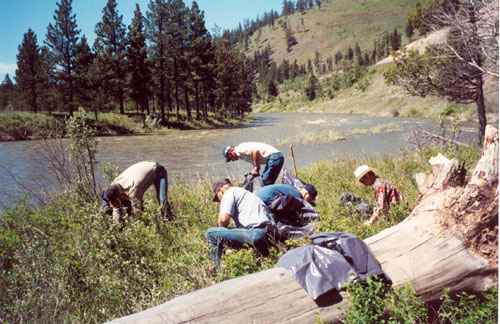Invasive Species Affects Our Fisheries
You Can Be Part Of The Solution!
- Check your gear and boat for plants, mud, and other organisms, and remove.
- Clean your gear with clean fresh water.
- Thoroughly dry your gear.
- Never transport plants, animals, sediment or bait fish among bodies of water.
- Educate yourself and find out what invasive species are in your area and inform others.
- Take the Clean Angling Pledge (Click Here)
Learn More About Invasive Species
New Zealand Mud Snail
(Potamopyrgus antipodarum)
The Mud Snail is a tiny snail native to New Zealand and discovered in the United States in the Snake River, Idaho in the 1980's. They have since spread to other rivers throughout the western USA. These snails have a wide range of habitat tolerances: rivers, reservoirs, lakes, and estuaries. Mud snails have no known predators or parasites in the USA.
Mud snails can rapidly reach densities greater than 100,000/m² in suitable habitat. Their invasion has generated concern about the effects it may have on native species, fisheries, and aquatic ecosystems. The spread of mud snails into new systems is considered to be primarily human caused.
How should I clean my gear? The best practices for all invasive species, including mud snails are to:
- Remove any plants,dirt or organisms from your gear before you leave the body of water
- Thoroughly rinse your gear with clean water
- Thoroughly dry your gear
- Brush your gear off after it has dried to remove any clinging snails, pay special attention to seams, boot tongue,laces and inserts
Didymo
(Didymosphenia geminata)
Click here for more information about the Didymo and to order a resource disk about this invasive species.

Anglers Against Weeds
Invasive weeds have spread across our country, damaging crops, and harming livestock and wildlife, out-competing valued native plants, and physically changing our natural environment. The economic and ecological impacts of invasive plants have been tremendous, and the problem is growing.
Since 1996, Anglers Against Weeds has been educating anglers and outdoor enthusiasts about invasive species and involving them in the fight to stop their spread. Participants learn how to recognize invasive weeds, what the impacts of those species can be, and how to actively participate in their management and control.
How Anglers Against Weeds Works
The Anglers Against Weeds program tackles invasive weeds through two primary mechanisms. In the first phase, Anglers Against Weeds facilitators visit clubs and organizations to present slide shows about noxious weeds, their impacts and avoiding their spread. In the second phase, the group is asked to "adopt" one or more stream areas where they will conduct hand-pulling projects to remove weeds from sensitive riparian areas.
Goals of the Program
- To educate anglers about weeds and their negative impacts. To provide anglers with proactive behaviors and techniques to use to fight invasive weeds.
- To develop partnerships between angling groups and others to carry out weed management activities.
- To actively engage angling groups and others in weed management activities including weed pulls and monitoring.
Get Your Group Involved Today and Plan A Project
If you need more information please contact the FFI Conservation Coordinator.
E-mail: conservation@flyfishersinternational.org
Telephone: 406-222-9369
Invasive Species Helpful Links
Invasive Species Action Network
Stop Aquatic Hitchhikers!
USDA National Invasive Species Information Center
Global Invasive Species Database
Invasive Species Task Force
Habitattitude
100th Meridian Initiative
Environmental Protection Agency
Biosecurity New Zealand